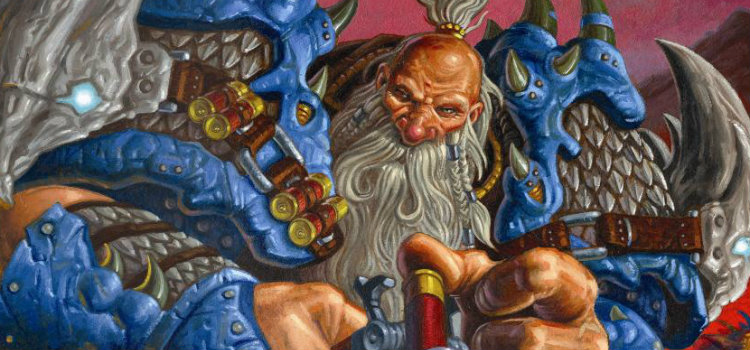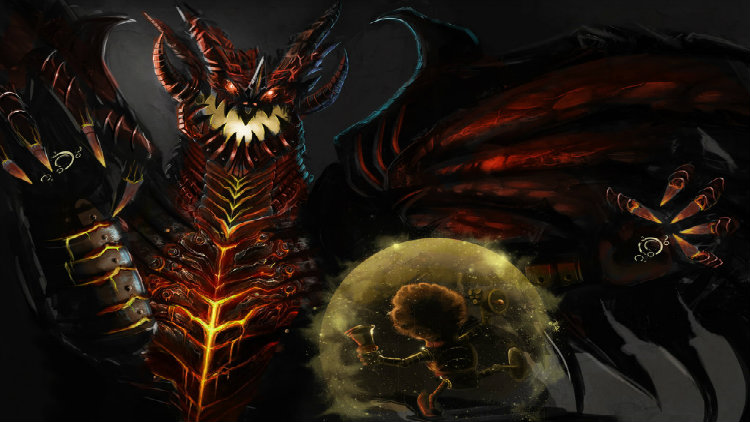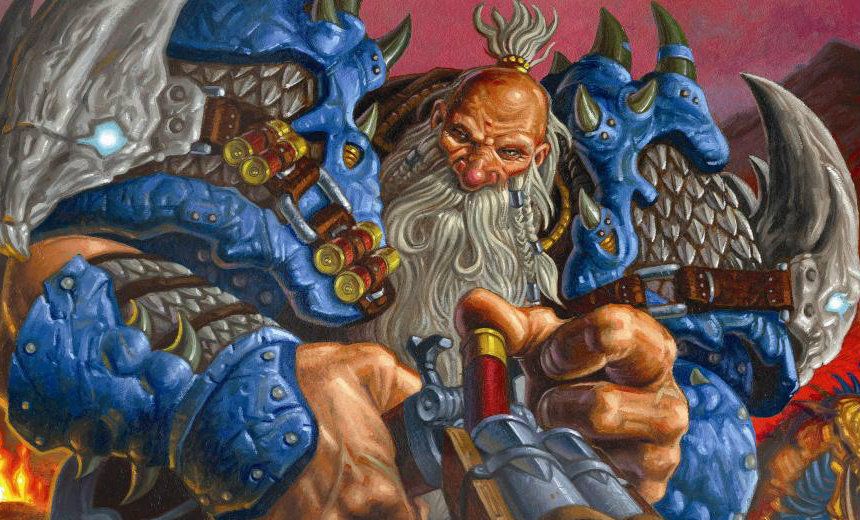
A little over two weeks ago, I posted my article “5 cards which will continue to cause problems in Hearthstone's future” and to say reactions were mixed would be quite generous. This was not at all surprising though as it was a very touchy subject in an area where people's ideas are bound to vary a lot.
There was one response that kept popping up, though. One opinion that was repeated more than any other: “Why no [card]Big Game Hunter[/card]?” “Where is BGH?” “You missed Big Game?” “BGH should be on the list for sure!” I can't say this is really surprising either. Big Game Hunter is one of the most critiqued cards in Hearthstone, mostly due to Brian Kibler's blog post “I’ve Got the Fun in my Sights!” With regards to this response and with Blackrock's dragons coming out, seemingly making less of an impact I thought this would be a good time to bring my own stance on the issue of Big Game Hunter.
Kibler's post points out that a number of cards like [card]Mogor the Ogre[/card] are made worse simply by having “too much attack” which is a very weird situation. The critique is understandable coming from a lover of dragons, as many dragons are eligible BGH targets. My own background is from Yu-Gi-Oh and there are plenty of awesome dragons there as well so I fully understand this.
What the article however fails to touch on is the fact that a lot of minions at the high mana slots are still not playable even if they're below the 7-attack threshold. [card]Boulderfist Ogre[/card] hasn’t seen use since the beta, Gallywix and Troggzor both flopped completely despite massive hype and even [card]Sneed's Old Shredder[/card] has seemingly fallen out of use.
The principle of inverse effort is a very common phenomenon in TCGs.
If BGH was the only thing keeping the strongest minions out then one would think that those just below would see an amount of play that would be at least noticeable. But that is far from the case. Most of the minions with a mana cost of 6 or more that see play in the meta tend to be medium-sized utility minions like [card]Emperor Thaurissan[/card]. Going up a few steps in the 7+ mana cost zone, there are no playable minions besides the highest tier of legendaries, even when there are plenty that dodge Big Game Hunter.
A major reason for the extinction of some of these cards besides BGH is the fast meta, a trend that has remained unstoppable for quite some time now. Some people have argued that the nature of the ladder nurtures a fast paced gameplay but that shouldn't really affect every single Hearthstone cards - if higher cost cards were viable, it would've been apparent. It isn't and I believe it all comes down to a much intricate subject, namely that too many elements of HS' gameplay promote a style based on high number of cheaper minions and outright punish singular big minions.
This is because Hearthstone suffers hard from what I like to call the principle of inverse effort. It is a very common phenomenon in TCGs and basically means that the more effort is put into a single play, the less effort will proportionally be required from the opponent to answer it. In Hearthstone's case this big play would be a single big expensive minion.
The principle of inverse effort stems from the fact that in a lot of TCGs there are cards and combinations that can essentially answer anything. These vary in their application and effort but it is almost always true that if a player uses such an answer against a play that took more effort than said answer, then the answering player will get an advantage in the form of tempo or overall card advantage.
This is true in Hearthstone as well and this is not necessarily bad for the game. Making plays that answer something that took more effort is the basis for comebacks. It is also what allows cards like [card]Innervate[/card] to exist and be balanceable, even if there are people saying that [card]Innervate[/card] is not currently balanced, a discussion for another article.
It becomes a problem though when these answers become so efficient that they phase out most higher or even medium cost cards. And I believe this is happening. A lot of mechanics and effects in Hearthstone are very absolute in their utility and upper limits like those seen on [card]Stampeding Kodo[/card] or [card]Shadow Word: Pain[/card] are the exception rather than the rule. That is the root of inverse effort and there are various ways this manifests in Hearthstone.
High mana minions in HS have less stats per mana than lower cost minions.
The first way this occurs is through the way stats are distributed in Hearthstone. High mana minions in Hearthstone have less stats per mana than lower cost minions. This is for the most part a positive thing as it maintains an environment where low cost minions can pose a threat through numbers without having high mana minions that just end the game instantly. It does however also bring the risk of an environment where single high mana minions dies very easily when facing a number of smaller minions.
The opposite can also occur where smaller minions can become virtually immortal at their mana cost. The pre-nerf Undertaker was the supreme incarnation of this, often requiring 300-400% of his own mana cost to be taken down. We see the same to some extent with the series of extremely sticky 2-drops like the [card]Shielded Minibot[/card] and [card]Annoy-o-tron[/card] with their divine shield and the [card]Haunted Creeper[/card] and its ability to spawn two 1/1s even after taking 2 damage itself.
High power minions will naturally have some limitations compared to having the same level of power bound to a bunch of 1/1 minions. With the latter example you can direct the damage exactly how you want and it is not as much of a hindrance if your opponent controls a sticky minion like [card]Shielded Minibot[/card]. With a single big minion however you run into issues where high attack easily become wasted especially if you are forced to attack into a weaker minion.
This makes taunts, especially cheaper ones, one of the biggest natural sources of inverse effort. Some of you who follow Trolden may remember an instance where [card]Annoy-o-tron[/card] took its name to the fullest when 2 of them stalled out 2 Deathwings.

It looks hilarious and it probably was awesome to play, but it is exactly those kind of interactions that completely kill off high cost minions as their impact is easily thwarted by minions that have less than 1/4 their mana cost. Other cheap taunts that enable this effect is [card]Voidwalker[/card] and the slime from Sludge Belcher. All of them are strong in the current meta due to their potential of eating up much more damage than their cost gives them any right to.
Another limitation to playing big minions - and subsequently an advocate for quicker decks - is uptrading. Uptrading refers to the act of using one or more low cost minions to remove a minion with a higher cost. Usually, that would result in card disadvantage, but there are a couple of reasons why currently this is not an issue.
With a single big minion, you run into issues where high attack easily become wasted especially if you are forced to attack into a weaker minion.
The first reason why the lost card advantage doesn't matter is because draw power in Hearthstone is surprisingly cheap compared to other TCGs. This is the section where people usually start shouting at Life Tap but this is an issue that is observed across the board. The combo of [card]Preparation[/card] and [card]Sprint[/card] for example has exactly the same ratio of mana and card advantage as two rounds of tap, even when Warlocks have much weaker class cards than Rogues. [card]Acolyte of Pain[/card] also frequently manages to get similar levels of card draw. This issue is broad and not one easily solved.
The second reason is that Hearthstone has an abundant number of minions that are essentially free. Whether those are spawns from a [card]Haunted Creeper[/card] or apprentices from a [card]Violet Teacher[/card], the common denominator is that they are cheap and highly disposable. This makes them ideal targets for a growing number of buffs, a lot of which have utterly absurd damage to mana ratio like [card]Power Overwhelming[/card], [card]Flametongue Totem[/card] or [card]Tinker's Sharpsword Oil[/card]. Alternatively, they can just take out a minion weakened by [card]Hunter's Mark[/card] or [card]Equality[/card], again cards with potential for a very high damage to mana ratio.
These buffs are also really strong when it comes to finishing the enemy hero. All of this enables decks which can take the board quickly and continue to trade upwards and build tempo with pretty much zero regards for how long the hand lasts because most of the time their opponent's life lasts shorter. And there are plenty of mechanics to supplement this strategy.
Even if BGH was nerfed or completely removed, there'd still be other mechanics in place to phase out higher cost minions.
Freezing and Divine Shield are two other mechanics which, through their nature, are very effective against high power minions. Freezing is the weaker of the two as it neither weakens the minion affected nor removes it from the board, it only stalls it but this is still enough to make [card]Frostbolt[/card] a decent utility when all that is needed is a little more time. Divine shield though can be brutal. There are no upper limits for how much damage a shield will tank, as shown with [card]Annoy-o-tron[/card] earlier. Neither of these mechanic are too big of an issue on their own though as they are both primarily restricted to a single class, Mage and Paladin respectively.
Secrets are another mechanic based a lot on inverse effort. Their costs are all static but a lot of them have their value scaled upward with the minion their effect gets used on. [card]Mirror Entity[/card] is the obvious example here completely copying any minion played regardless of power level. [card]Freezing Trap[/card] is also extremely efficient in this regard as its conditioning for activation can make it very hard to “disarm” with a weak minion yet it is always relevant when a big minion want to attack unlike [card]Vaporize[/card] which only triggers when the minions attacks the hero.
Finally we get to minion removal cards. By design they are all bound to follow inverse effort. [card]Assassinate[/card] is the simplest incarnation of this and its simplicity is at the same time why it sees practically no play. For Assassinate to be a tempo play it must be used on a minion that cost 6 or more and loses all of its value through death. This harsh condition is why Assassinate rarely sees play. It has no gimmicks, very little potential, it is just raw removal and its cost is appropriate for that.
Problems occur quickly with similar cards where gimmicks are added to supposedly make up for a reduced mana cost. [card]Sap[/card] is the perfect example of this. For just two mana it applies seemingly the same effect of taking out a minion but at much lower mana cost. The supposed trade-off for this is that Sap returns the minion to the hand thus maintaining the overall card advantage.
However, as was the case with the uptrading, so it is here and the overall card advantage doesn't matter much. More often than not it is a good thing that Sap doesn't kill the target due to deathrattles or death-related effects. On top of this is its humble two mana cost for almost unconditional use, often earning 4 or more mana worth of tempo. Such a tempo loss will often lose the game or be irrelevant in an eventual win making Sap the kind of card slowing pushing out higher cost cards. And there are plenty of cards like Sap.
[card]Execute[/card] is another example. Its 1 mana cost might actually have been justifiable in times where dealing one damage was something that took Warriors a marginal degree of effort. But today dealing one damage is literally all they do, even to their own minions. It makes Execute one of the biggest examples of absolute removal where only the sky is the limit for how much tempo you can get. Leaving it up to the rest of us to not play the cards that gets too impacted by this.
I could go on. There are several cards in Hearthstone that for 3 mana or less will remove almost any minion off the board regardless of that minion's overall power or cost. This puts the bar for which minions are realistically playable quite low compared to the maximum mana in Hearthstone.
Cheap removal is game swinging but the mechanic that punishes higher cost minions the most is getting them stolen.
Cheap removal is game swinging but the mechanic that punishes higher cost minions the most is getting them stolen. It is always a gain in overall card advantage and the tempo gained is equal to the value of the stolen minion times two. It is through this principle and general utility that Sylvanas earned my spot as the #2 most problematic card of the future and I stand by it. Even [card]Mind Control[/card] is incredibly powerful on an almost game-breaking level. It doesn't really show right now since the rest of Priest consists mostly of situational overcosted junk but if we had a less aggressive format or if it was available to another class that actually saw consistent play then Mind Control would be one of the most imbalanced cards in the game. Even at 10 mana.
When all is said it would be futile to try and name any one of the aforementioned mechanics as the sole reason why most high cost minions in Hearthstone don't see play. Rather it is the combined presence of all of them that slowly but surely phases them out. Redundancy is the biggest killer of strategies and when having a 6+ manacost is something that by default brings 6-7 different weaknesses against basically any strategy then it is no surprise that only the very highest tier of legendaries with that cost get a chance to see play. And even that might change if we see more cards that work in favor of the inverse effort.
Big Game Hunter is the biggest incarnation of all of this. Everything in his design is about inverse effort. Give him 3 mana and a clear target and he will remove anything with 7 or more attack. That is the only thing he does. And that is exactly why I don't see him as a big part of the problem. He is one of the most specialized and situational cards I have talked about. He doesn't work on the vast majority of minions unlike [card]Execute[/card] or [card]Sap[/card]. He doesn't have alternative use to finish the game unlike Power Overwhelming. And even if he was nerfed or completely removed there would still be all of these other mechanics in place to make sure that higher cost minions gradually but certainly gets phased out of Hearthstone.
If Blizzard sees any of this as an issue then I don't envy them. The task of adjusting all of this going forward is going to be daunting and likely require a complete change of direction and potentially change of cards. It will be tough to make a call on which, if any, changes are needed. After all, there are a lot of elements of inverse effort that are positive. But if things stay as they are now, then endless aggression is all we can ever expect to see. It is really about maintaining a solid balance between risk and reward of big higher cost minions and trying to ensure that a variety of strategies can exist. And that right now, is a balance I think can be improved on.
More on Follow @GosuGamersHS





